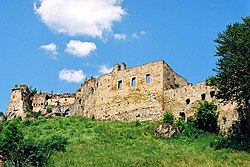Odrzykoń
Village in Subcarpathian Voivodeship, Poland From Wikipedia, the free encyclopedia
Odrzykoń [ɔˈdʐɨkɔɲ] is a village in the administrative district of Gmina Wojaszówka, within Krosno County, Subcarpathian Voivodeship, in south-eastern Poland. It lies approximately 7 kilometres (4 mi) south-east of Wojaszówka, 8 km (5 mi) north of Krosno, and 37 km (23 mi) south-west of the regional capital Rzeszów.[1]
This article relies largely or entirely on a single source. (February 2025) |
Odrzykoń | |
|---|---|
Village | |
 Ruins of Kamieniec Castle, first recorded mention in 1348 | |
| Coordinates: 49°45′N 21°45′E | |
| Country | Poland |
| Voivodeship | Subcarpathian |
| County | Krosno |
| Gmina | Wojaszówka |
| Population | |
• Total | 2,900 |
The history of human settlement here dates back to the period known as the Lusatian culture. In early Middle Ages, a Slavic gord existed here, later replaced with a wooden castle. The castle was burned during the Mongol invasions of Poland, first in 1241 and again in 1259. In a 1348 document, the village was spelled Kamieniec; in 1402 - Ehremberg alias Orzykon; and in 1446, Odrzykoń.
In 1348, King Kazimierz Wielki built here Kamieniec Castle, which remained private property of the Kamieniecki family. In 1475, the castle was attacked by Hungarian troops of Matthias Corvinus. On March 12, 1526, Crown Hetman Marcin Kamieniecki invited to the castle Hungarian King John Zapolya, also Fausto Sozzini visited Kamieniec. On December 7, 1655, near Odrzykoń, a choragiew of Gabriel Wojnillowicz defeated Swedes in the Battle of Krosno (see Deluge (history)). On March 16, 1657, the army of George II Rakoczi, allied with the Swedish Empire, entered southern Poland, capturing and burning the Kamieniec Castle. Rebuilt, the complex was once again destroyed by Swedes during the Great Northern War. During Bar Confederation, Polish rebels found refuge in the ruined and neglected castle.
In 1828, following the marriage of Aleksander Fredro with Zofia Skarbowa, the famous writer became owner of half of the ruined complex. Fredro based his Zemsta on a mid-17th century lawsuit between owners of the castle, Piotr Firlej and Jan Skotnicki. In 1831, after the November Uprising, a demented man named Jan Machnik of Dukla resided in the ruins. Seweryn Goszczynski based main character of his book “Król zamczyska” (“King of the Castle”) on Machnik.
- Tadeusz Kościuszko monument, 1894
References
Wikiwand - on
Seamless Wikipedia browsing. On steroids.



